Mechanical Properties and Hydrogen Embrittlement of Laser-Surface Melted AISI 430 Ferritic Stainless Steel
Abstract
1. Introduction
2. Experimental Details
3. Results and Discussion
3.1. Microstructural Analysis
3.2. Microhardness
3.3. Tensile Properties
3.4. Fractography
4. Conclusions
- The austenite contents for the laser-surface melted samples V60 and V80 are found to be 0.6 and 1.9 wt%, respectively. The amount of retained austenite reduces as the laser scanning speed decreases;
- At higher laser scanning speed, the quenching rate is higher resulting in more austenite. The microhardness at MZ and HAZ of laser-surface melted samples is about 270–280 HV0.2 and 220 HV0.2, respectively. Lower microhardness in V80 is due to a higher austenite content;
- After hydrogen pre-charging, the ductility of as-received AISI 430 steel was reduced from 0.44 to 0.25, while the laser-surface melted AISI 430 steel showed similar tensile properties as the as-received one. After LSM, the value of hydrogen embrittlement susceptibility Iδ decreases from 43.2% to 38.9% and 38.2% for V60 and V80, respectively, due to the presence of martensite. The hydrogen embrittlement susceptibilities of both V60 and V80 decrease due to the presence of martensite;
- Brittle fracture is observed in the melt zone of the laser-surface melted AISI 430 steel, while ductile fracture is observed in the as-received AISI 430 steel. After LSM, the main fracture mode changes from intergranular to a mixture of intergranular and quasi-cleavage fracture. The austenite formed in V60 and V80 can lessen the effect of hydrogen embrittlement. The effect of LSM dominates over the effect of hydrogen pre-charging on fracture morphologies.
Author Contributions
Funding
Acknowledgments
Conflicts of Interest
References and Note
- Timothy, T.M.; Hwang, S.J.; Bowman, R.C.; Birkmire, D.S.; Jense, C.M.; Udovic, T.J.; Conradi, M.S. Discovery of a new Al species in hydrogen reactions of NaAlH4. J. Phys. Chem. Lett. 2010, 1, 2412–2416. [Google Scholar]
- Riecke, E. Wasserstoff in Eisen und Stahl. Arch. Für Das Eisenhüttenwesen 1978, 49, 509–520. [Google Scholar] [CrossRef]
- Hofmann, W.; Rauls, W. Ductility of Steel Under the Influence of External High Pressure Hydrogen. Weld. Res. Suppl. 1965, 44, 225–230. [Google Scholar]
- Frick, V.; Janser, G.R.; Brown, J.A. Space Shuttle Mater.1971, Sampe, Azusa 3. 579–634.
- Fukuyama, S.; Sun, D.; Zhang, L.; Wen, M.; Yokogawa, K. Effect of temperature on hydrogen environment embrittlement of type 316 series austenitic stainless steels at low temperatures. J. Jpn. Inst. Met. 2003, 67, 456–459. [Google Scholar] [CrossRef]
- Abdalla, A.M.; Hossain, S.; Nisfindy, O.B.; Azad, A.T.; Dawood, M.; Azad, A.K. Hydrogen production, storage, transportation and key challenges with applications: A review. Energy Convers. Manag. 2018, 165, 602–627. [Google Scholar] [CrossRef]
- Owczarek, E.; Zakroczymski, T. Hydrogen transport in a duplex stainless steel. Acta Mater. 2000, 48, 3059–3070. [Google Scholar] [CrossRef]
- Zakroczymski, T.; Owczarek, E. Electrochemical investigation of hydrogen absorption in a duplex stainless steel. Acta Mater. 2002, 50, 2701–2713. [Google Scholar] [CrossRef]
- Michler, T.; Naumann, J. Coatings to reduce hydrogen environment embrittlement of 304 austenitic stainless steel. Surf. Coat. Technol. 2009, 203, 1819–1828. [Google Scholar] [CrossRef]
- Kwok, C.T. Laser Surface Modification of Alloys for Corrosion and Erosion Resistance; Woodhead Publishing: Sawston, Cambridge, UK, 2012; pp. 3–40. [Google Scholar]
- Ready, J.F.; Farson, D.F.; Feeley, T. LIA Handbook of Laser Materials Processing; Springer-Verlag: Orlando, FL, USA, 2001; pp. 273–279. [Google Scholar]
- Conde, A.; Colaco, R.; Vilar, R.; de Damborenea, J. Corrosion behaviour of steels after laser surface melting. Mater. Des. 2000, 21, 441–445. [Google Scholar] [CrossRef]
- Zakroczymski, T.; Glowacka, A.; Swiatnicki, W. Effect of hydrogen concentration on the embrittlement of a duplex stainless steel. Corros. Sci. 2005, 47, 1403–1414. [Google Scholar] [CrossRef]
- ASTM G129-00 (2013). Standard Practice for Slow Strain Rate Testing to Evaluate the Susceptibility of Metallic Materials to Environmentally Assisted Cracking; ASTM International: West Conshohocken, PA, USA, 2013. [Google Scholar]
- Fan, Y.H.; Zhang, B.; Yi, H.L.; Hao, G.S.; Sun, Y.Y.; Wang, J.Q.; Hana, E.H.; Ke, W. The role of reversed austenite in hydrogen embrittlement fracture of S41500 martensitic stainless steel. Acta Mater. 2017, 139, 188–195. [Google Scholar] [CrossRef]
- Castro, R.; Tricot, R. Études des transformations isothermes dans les aciers inoxydables semi-ferritiques á 17% de chrome. Mem. Sci. De La Rev. De Metall. 1962, 59 (Pt 1), (Pt 2), 571–586, 587–596. [Google Scholar]
- David, S.A.; Vitek, J.M.; Hebble, T.L. Effect of rapid solidification on stainless steel weld metal microstructures and its implication on the Schaffler diagrams. Weld. J. 1987, 66, 289–300. [Google Scholar]
- Delong, W.T.; Ostrom, G.A.; Szumachowski, E.R. Measurement and calulation of ferrite in stainless steel Weld Metal. Weld. J. 1956, 35, 526–533. [Google Scholar]
- Kaltenhauser, R.H. Improving the engineering properties of ferritic stainless steels. Met. Eng. Q. 1971, 11, 41–47. [Google Scholar]
- Balmforth, M.C.; Lippold, J.C. A new ferritic-martensitic stainless steel constitution diagram. Weld. J. 2000, 79, 339–345. [Google Scholar]
- Colacë O, R.; Vilar, R. Effect of the processing parameters on the proportion of retained austenite in laser surface melted tool steel. J. Mater. Sci. Lett. 1998, 17, 563–567. [Google Scholar] [CrossRef]
- Sundqvist, J.; Manninen, T.; Heikkinen, H.P.; Anttila, S.; Kaplan, A.F.H. Laser surface hardening of 11% Cr ferritic stainless steel and its sensitization behavior. Surf. Coat. Technol. 2018, 344, 673–679. [Google Scholar] [CrossRef]
- Khorram, A.; Jamaloei, A.D.; Jafari, A.; Moradi, M. Nd:YAG laser surface hardening of AISI 431 stainless steel; mechanical andmetallurgical investigation. Optics Laser Technol. 2019, 119, 105617. [Google Scholar] [CrossRef]
- Nelson, H.G.; Stein, J.E. Gas-phase Hydrogen Permeation through Alpha Iron, 4130 Steel, and 304 Stainless Steel from less than 100 °C to near 600 °C. NASA TN D-7265; Ames Research Center, National Aeronautics and Space Administration: Moffett Field, CA, USA, April 1973. [Google Scholar]
- Tavares, S.S.M.; da Silva, G.F.; Parda, J.M.; Silva, M.R.; de Abreu, H.F.G. Influence of heat treatments on toughness and sensitization of a Ti-alloyed supermartensitic stainless steel. J. Mater. Sci. 2011, 46, 7737–7747. [Google Scholar]
- Gesnouin, C.; Hazarabedian, A.; Bruzzoni, P.; Ovejero-Garcia, J.; Bilmes, P.; Llorente, C. Effect of post-weld heat treatment on the microstructure and hydrogen permeation of 13CrNiMo steels. Corros. Sci. 2004, 46, 1633–1647. [Google Scholar] [CrossRef]
- Sebastián, Z.; Estela, S.; Hernán, S. Effects of welding procedure on corrosion resistance and hydrogen Embrittlement of supermartensitic stainless steel deposits. J. Iron Steel Res. Int. 2013, 20, 124–132. [Google Scholar] [CrossRef]
- Tavares, S.S.M.; Bastos, I.N.; Pardal, J.M.; Montenegro, T.R.; da Silva, M.R. Slow strain rate tensile test results of new multiphase 17%Cr stainless steel under hydrogen cathodic charging. Int. J. Hydrog. Energy 2015, 40, 16992–16999. [Google Scholar] [CrossRef]
- Beachem, C.D. A new model for hydrogen assisted cracking (hydrogen embrittlement). Metall. Mater. Trans. 1972, A3, 437–451. [Google Scholar] [CrossRef]
- Ohmura, T.; Minor, A.M.; Stach, E.A.; Morris, J.W. Dislocationegrain boundary interactions in martensitic steel observed through in situ nanoindentation in a transmission electron microscope. J. Mater. Res. 2004, 19, 3626–3632. [Google Scholar] [CrossRef]
- Eastman, J.; Matsumoto, T.; Narita, N.; Heubaum, F.; Birnbaum, H.K. Hydrogen in Metals; Bernstein, I.M., Thompson, A.W., Eds.; TMS: New York, NY, USA, 1981; pp. 397–409. [Google Scholar]
- Malitckii, E.; Yagodzinskyy, Y.; Lehto, P.; Remes, H.; Romu, J.; Hänninen, H. Hydrogen effects on mechanical properties of 18%Cr ferritic stainless steel. Mater. Sci. Eng. A 2017, 700, 331–337. [Google Scholar] [CrossRef]
- Li, X.; Zhang, J.; Chen, J.; Shen, S.; Yang, G.; Wang, T.; Song, X. Effect of aging treatment on hydrogen embrittlement of PH 13-8 Mo martensite stainless steel. Mater. Sci. Eng. 2016, A651, 474–485. [Google Scholar] [CrossRef]
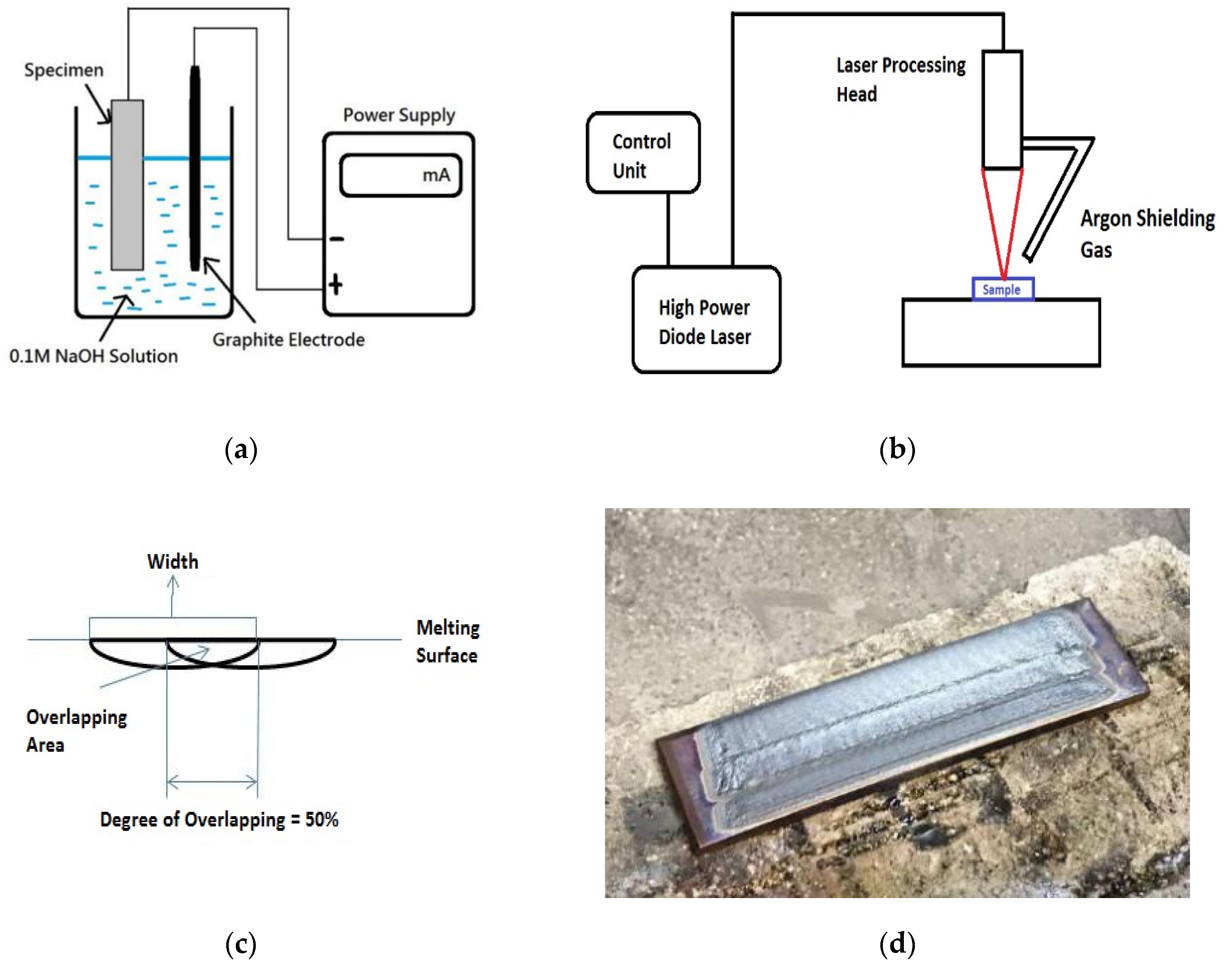

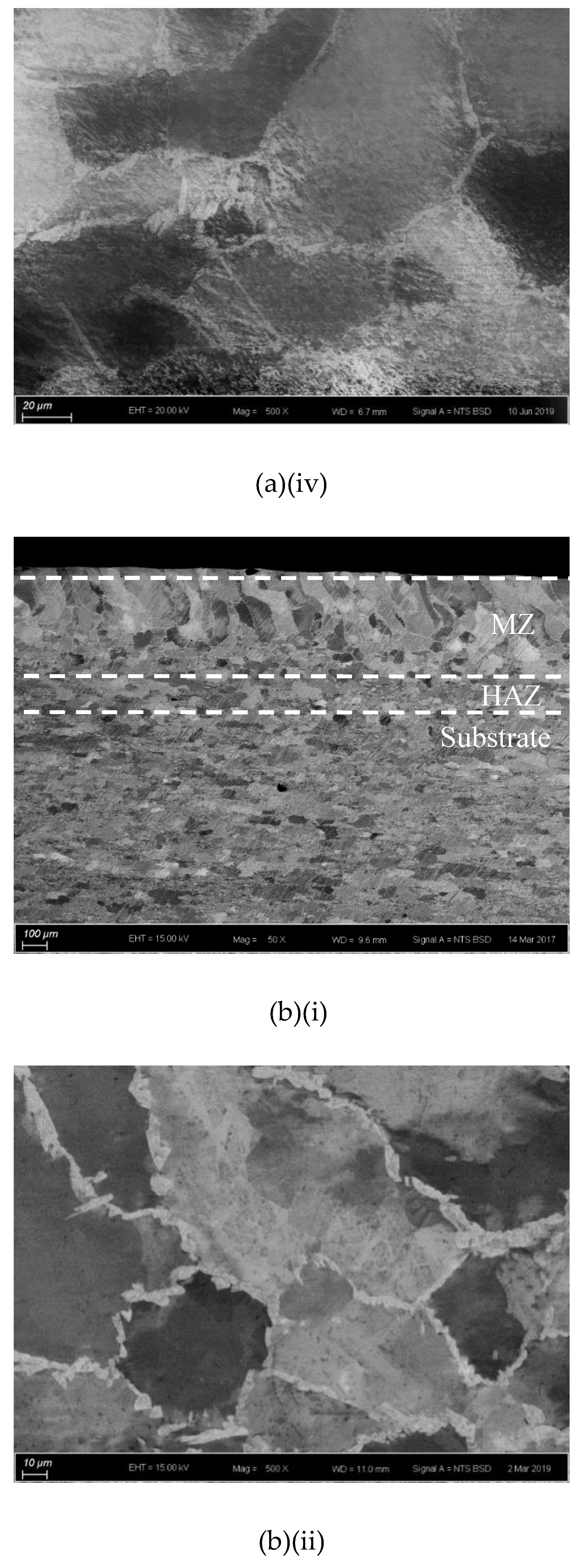


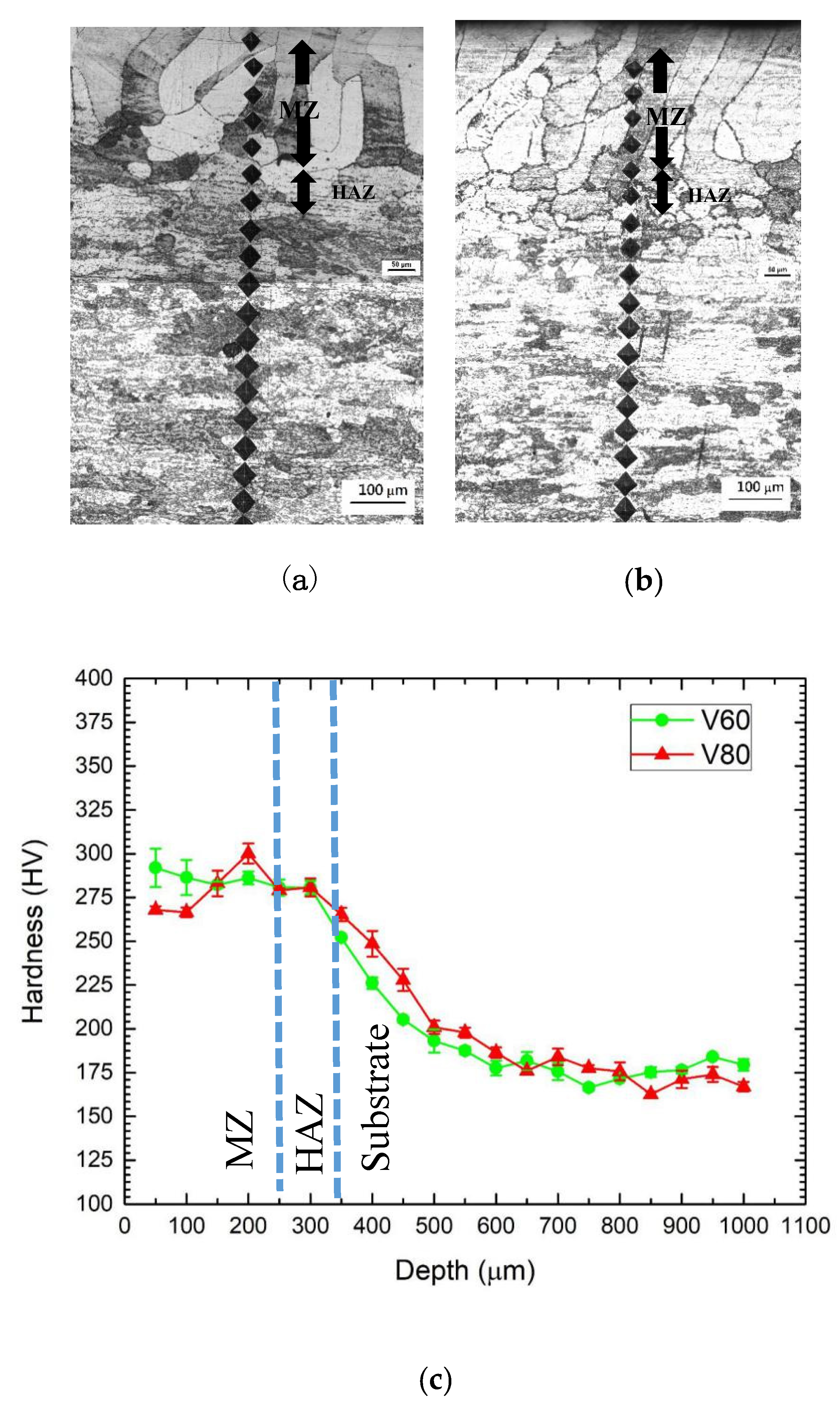

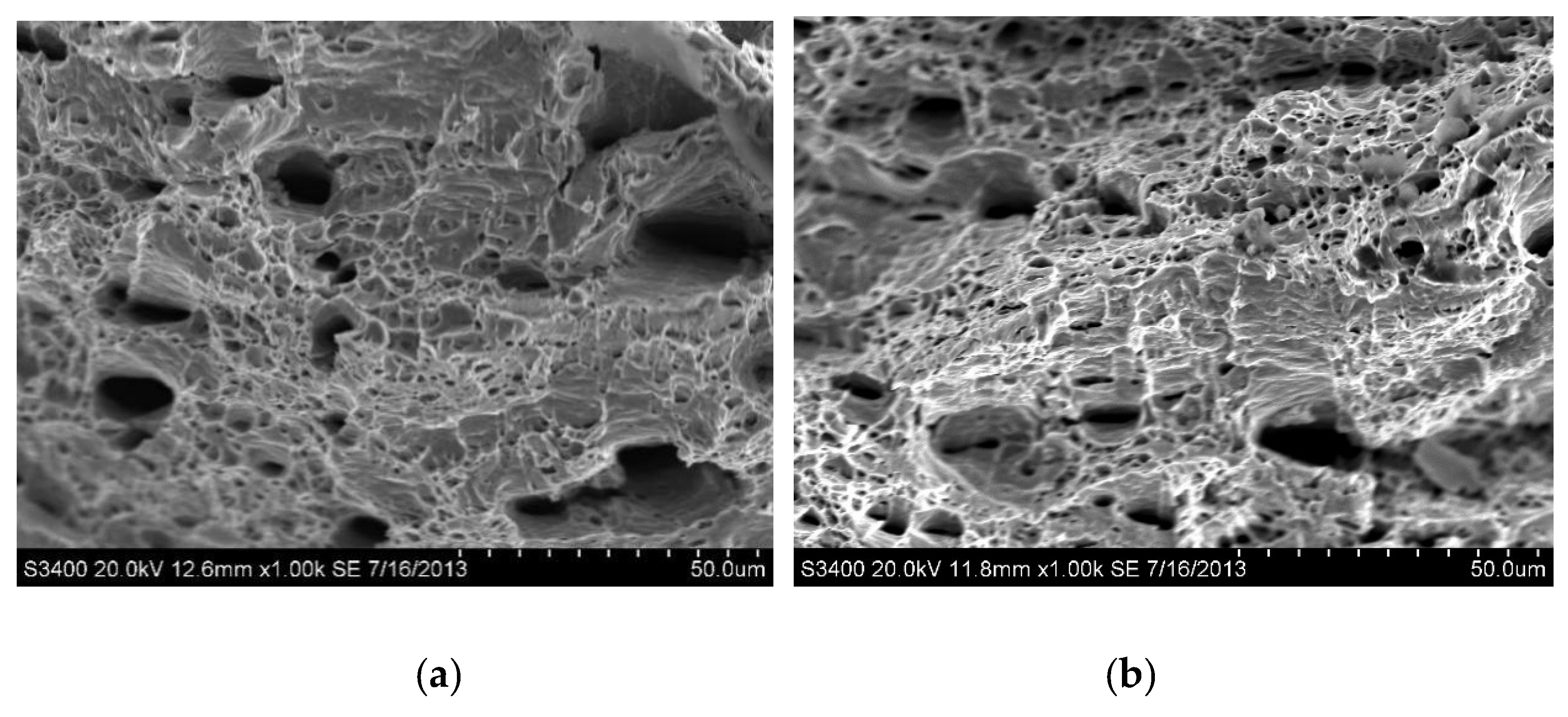
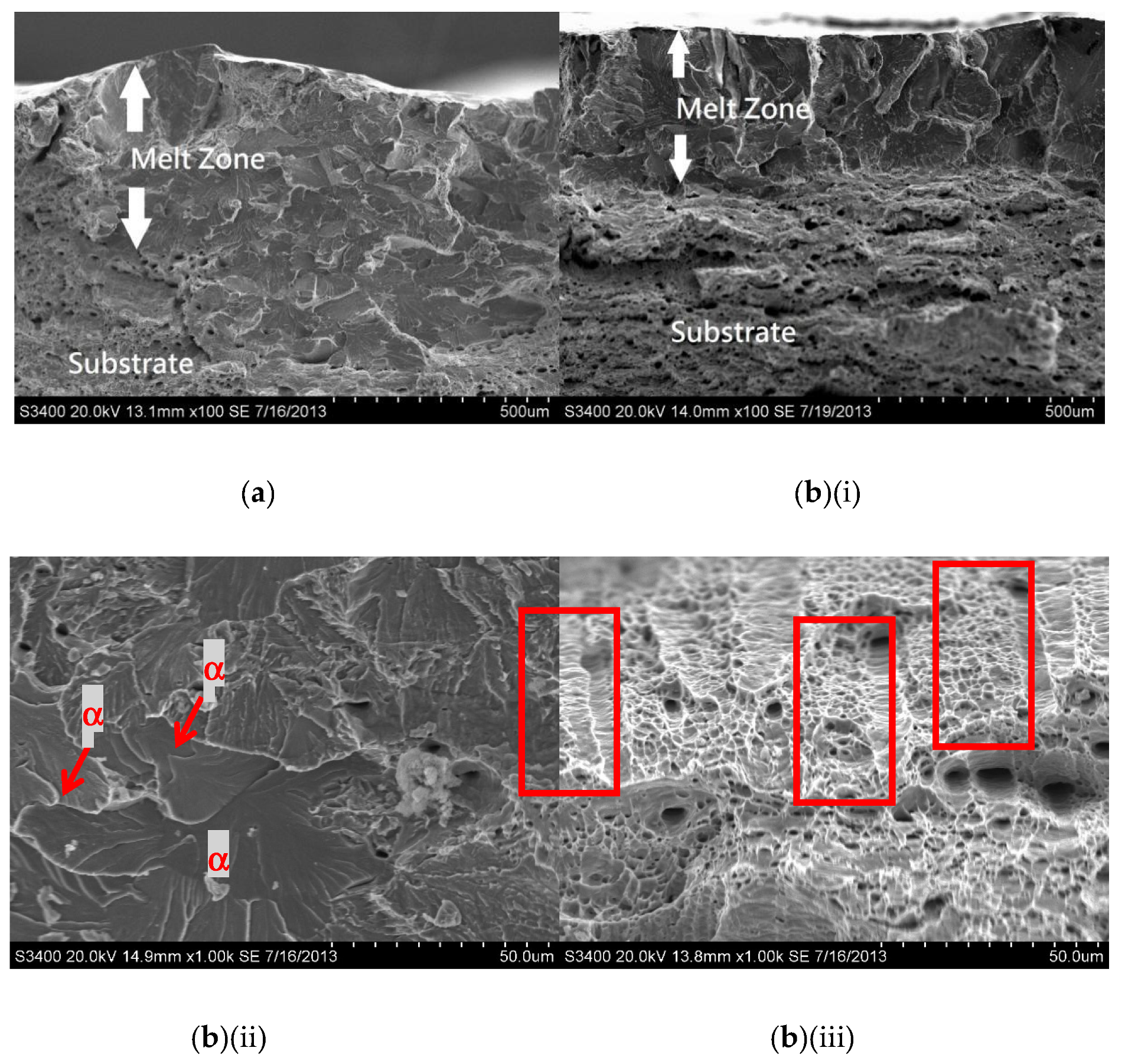
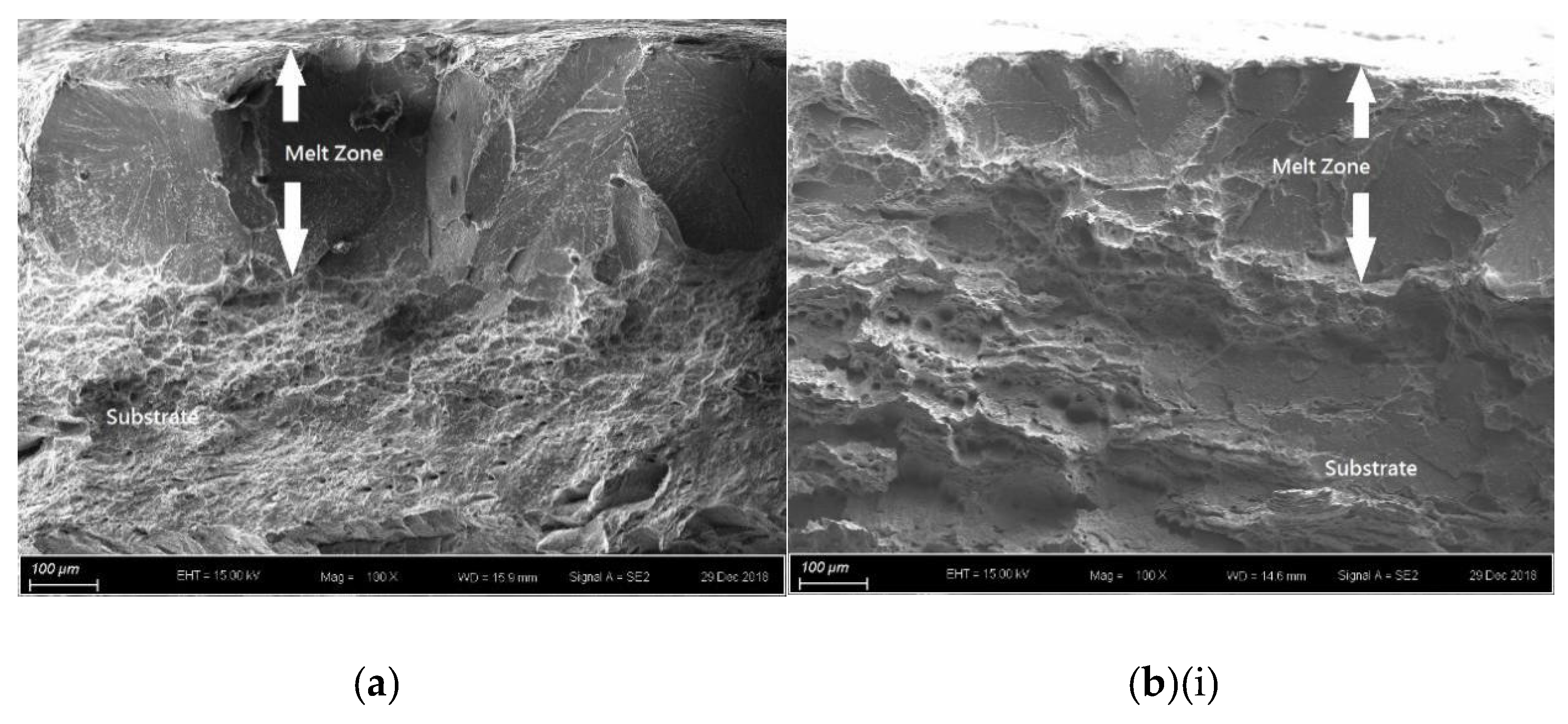

| Element | Fe | Cr | Ni | Mn | Si | C | P | S |
|---|---|---|---|---|---|---|---|---|
| wt-% | Bal. | 16.1 | 0.10 | 0.29 | 0.224 | 0.12 | 0.019 | 0.004 |
| (i) As-received | (ii) V60 | (iii) V80 | |
|---|---|---|---|
| (a) Without hydrogen pre-charging | M/X/H/T/F | M/X/H/T/F | M/X/H/T/F |
| (b) With hydrogen pre-charging | T/F | T/F | T/F |
| As-Received Steel AISI 430 | V60 | V80 | |
|---|---|---|---|
| Average grain size of ferrite in substrate (μm) | 15 ± 2 | - | - |
| Average grain size of ferrite in MZ (μm) | - | 67 ± 41 | 57 ± 29 |
| Average grain size of ferrite in HAZ (μm) | - | 48 ± 7 | 44 ± 4 |
| Martensite content (%) | 0 | 5.4 | 4.8 |
| Austenite content (%) | 0 | 0.6 | 1.9 |
| Thickness of MZ (μm) | N/A | 264 ± 20 | 255 ± 18 |
| Thickness of HAZ (μm) | N/A | 74 ± 11 | 77 ± 7 |
| Yield Strength (MPa) | Tensile Strength (MPa) | Ductility (% Elongation) | HE Susceptibility (Iδ) | |
|---|---|---|---|---|
| (a) As-received AISI 430 steel | 348 | 488 | 0.44 | 43.2% |
| (b) As-received AISI 430 steel after charging | 364 | 462 | 0.25 | |
| (c) V60 | 377 | 544 | 0.36 | 38.9% |
| (d) V60 after charging | 376 | 471 | 0.22 | |
| (e) V80 | 326 | 530 | 0.34 | 38.2% |
| (f) V80 after charging | 327 | 474 | 0.21 |
© 2020 by the authors. Licensee MDPI, Basel, Switzerland. This article is an open access article distributed under the terms and conditions of the Creative Commons Attribution (CC BY) license (http://creativecommons.org/licenses/by/4.0/).
Share and Cite
Chan, W.K.; Kwok, C.T.; Lo, K.H. Mechanical Properties and Hydrogen Embrittlement of Laser-Surface Melted AISI 430 Ferritic Stainless Steel. Coatings 2020, 10, 140. https://doi.org/10.3390/coatings10020140
Chan WK, Kwok CT, Lo KH. Mechanical Properties and Hydrogen Embrittlement of Laser-Surface Melted AISI 430 Ferritic Stainless Steel. Coatings. 2020; 10(2):140. https://doi.org/10.3390/coatings10020140
Chicago/Turabian StyleChan, W. K., C. T. Kwok, and K. H. Lo. 2020. "Mechanical Properties and Hydrogen Embrittlement of Laser-Surface Melted AISI 430 Ferritic Stainless Steel" Coatings 10, no. 2: 140. https://doi.org/10.3390/coatings10020140
APA StyleChan, W. K., Kwok, C. T., & Lo, K. H. (2020). Mechanical Properties and Hydrogen Embrittlement of Laser-Surface Melted AISI 430 Ferritic Stainless Steel. Coatings, 10(2), 140. https://doi.org/10.3390/coatings10020140




